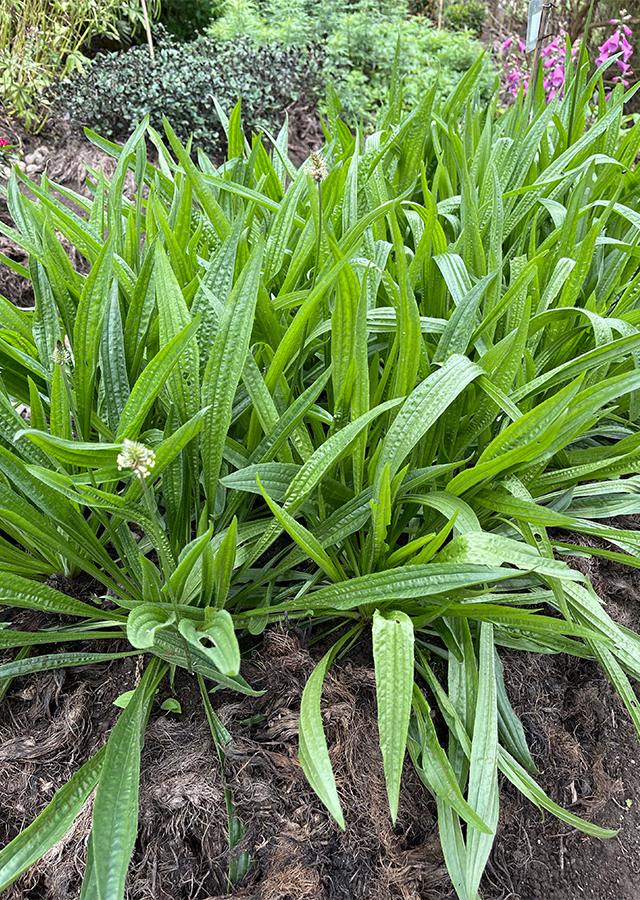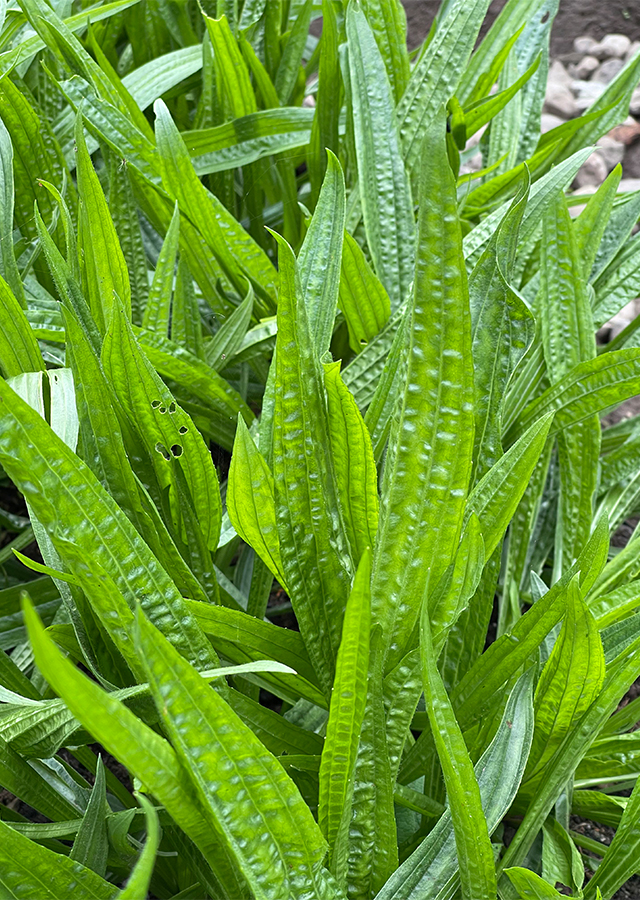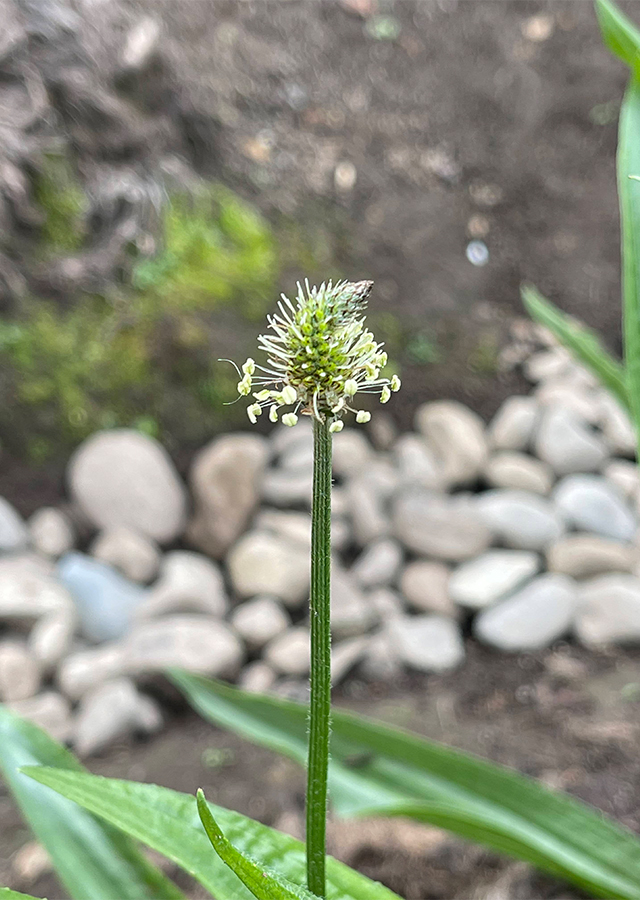Ribwort Plantain
Plantago lanceolata L.
Plantaginaceae
Location in our garden
Principal



Synonym
Arnoglossum lanceolatum (L.) Gray
Lagopus lanceolatus (L.) Fourr.
Plantago argentea Brot.
Habitus
Herbaceous. A biennial to perennial low herb that can grow 10-60 cm tall.
Part Used
Leaves
Seeds
Roots
The Whole Plant
Growing Requirements
Full Sunshine
Habitat
Roadside
Grassland
Terrestrial
Overview
Originally from Europe and western Asia, Plantago lanceolata is now cosmopolitan, including some tropical highland regions. The plant is harvested from the wild for local use as a food, medicine and source of materials. A good fibre is obtained from the leaves, it is said to be suitable for textiles. A mucilage from the seed coats is used as a fabric stiffener. It is an excellent thickener that is used in cosmetics such as lotions and hair wave sets. The seeds can be used as a source of a low-cost gelling agent suitable for tissue culture. Young leaves is edible, raw or cooked. They are rather bitter and very tedious to prepare, the fibrous strands are best removed prior to eating. The very young leaves are somewhat better and are less fibrous. Seed is cooked, and used like sago. The seed can be ground into a powder and added to flours when making bread, cakes or whatever. A mucilage obtained from the seed coats is an excellent thickener and stabilizer that is used in the ice-cream industry and also in the preparation of chocolate.
Vernacular Names
Petit plantain (French), llantén menor (Spanish), Tanchagem menor (Portuguese), Heraoobako (Japanese), Ch'e-ch'len (Chinese), Lanting-haba (Tagalog-Philippines), Bolilanyana (South Africa).
Agroecology
A plant of grasslands and wastelands with neutral or basic soils. It is found in a wider range of grassland microclimates and soil types than some close relatives, but is not found in the hottest and driest grasslands. In general, it is restricted to comparatively open vegetation where there is plenty of light at ground level. Succeeds in any moderately fertile soil in a sunny position. Plants also succeed in very poor land. The seeds readily adhere to animals or people, which promotes dispersal. They can also be transported by water. The plant is a common weed of cultivated land and grassland in the temperate to subtropical regions, also spreading into the tropics, where it is mainly found at moderate to higher elevations.
Morphology
- Root/rhizome - short thick rootstock, taproot.
- Leaves - in several rosettes, narrowly lanceolate to linear-lanceolate or narrowly elliptical, (2-)10-25(-40) cm × (0.5-)1-3(-5) cm, entire or remotely and shallowly denticulate, subglabrous or appressed pubescent to villous; spike 0.5-5(-8) cm long, very dense, bracts ovate, about 3 mm long.
- Flowers - bisexual, inconspicuous, corolla 4-lobed, tubular, almost as long as surrounding calyx. Corolla tube 2-3 mm, glabrous, the lobes 1.5-2.5 mm lanceolate to ovate, acute or acuminate, glabrous. Stamens 4, exserted, conspicuous, 3-5 mm long, the anthers yellowish.
- Fruit - 3-4 mm long, 2-seeded.
- Seeds - boat-shaped, about 2 mm long, smooth, brown.
Cultivation
- Generatively propagated by seed - sow in situ.
- The seeds have a dormancy period of one to several months, which can be broken by dry storage
at 5 °C for several weeks or 20 °C for several months. - Germination is best for 1-6-year-old seeds and at temperatures of 25-30 °C.
Chemical Constituents
Alkaloids, flavonoids (apigenin, luteolin), saponins, glycosides, phenols, tannins, terpenoids, coumarins, mucilage, polysaccharides, iridoid glycosides (aucubin, catalpol and asperuloside).
Traditional Medicinal Uses
- It helps to detoxify the body and is a safe and effective treatment for bleeding, iuickly staunching blood flow and encouraging the repair of damaged tissue.
- The seeds stimulates peristalsis and facilitates bowel movements.
- The mucilage can also be used as supportive therapy in diarrhoea.
Part Used
Reference Sources
- CAB International. (2022). Invasive Species Compendium: Plantago lanceolata (ribwort plantain). https://www.cabi.org/isc/datasheet/41813#tosummaryOfInvasiveness. 25-06-2022.
- Fern, Ken. (2021). Useful Tropical Plants: Plantago lanceolata. http://tropical.theferns.info/viewtropical.php?id=Plantago+lanceolata. 25-06-2022.
- Kew Royal Botanic Gardens. (No date). Plants of the World Online: Plantago lanceolata. https://powo.science.kew.org/taxon/urn:lsid:ipni.org:names:321285-2. 25-06-2022.
- Pangemanan, Lilis. (2016). Plantago lanceolata (PROSEA). https://uses.plantnet-project.org/en/Plantago_lanceolata_(PROSEA). 25-06-2022.
- Stuartxchange. (2018). Philippine Medicinal Plants: Lanting-haba. http://www.stuartxchange.org/Lanting-haba.html. 25-06-2022.


